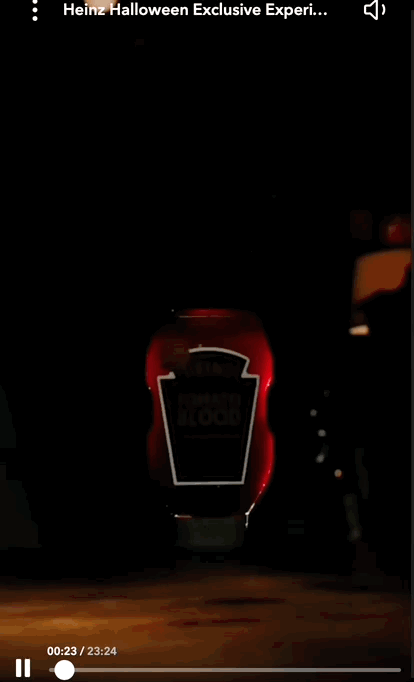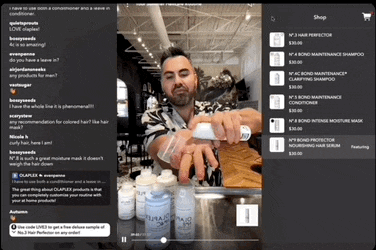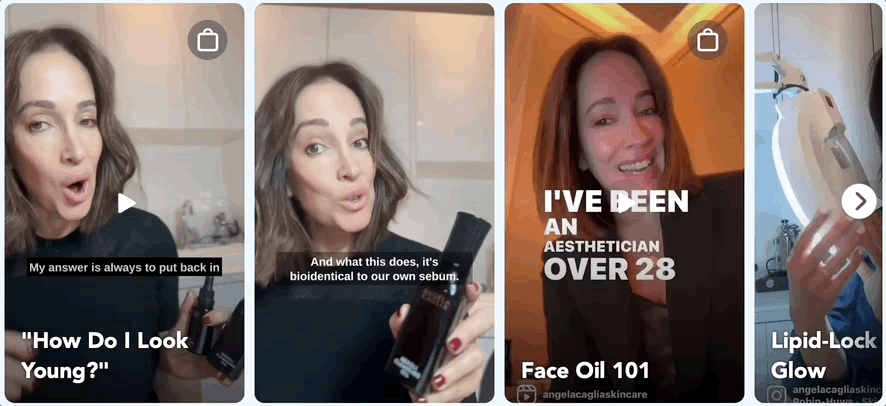The start of this decade witnessed the phenomenal explosion of video commerce. Videos are a highly engaging medium and influence overall buying behavior – right from research to consideration to actual purchase.
Moreover, video is becoming an essential medium for brand-consumer communication and has immense potential to drive engagement and conversions. Video content helps brands showcase products, build trust, convey information more engagingly, and boost sales.
What Is Video Commerce?
Video commerce leverages live and shoppable video content to make the purchasing process immersive and experiential for consumers. As a result, it is a new-age interactive engagement medium that uses video content to showcase and sell products.
The key components of video commerce include:
1. Short, shoppable videos
These are pre-recorded videos that are typically no longer than a few minutes. Brands create short shoppable videos to engage and inform viewers, highlighting key features and benefits of a product in a way that encourages them to make a purchase.
In addition, shoppable videos can be embedded on a product page on a brand’s website often including links or call-to-action that make it easy for viewers to buy the product as they view the video.
2. Livestream shopping
This is a form of video commerce that involves livestreaming products to an audience. During a livestream event, a host demonstrates products, answers questions, and enables viewers to place orders in real-time.
Livestream shopping is a popular way for retailers to connect with customers and create a more personal and interactive shopping experience. Live streaming will be a $35 billion industry in the US alone by 2024.
3. Video ads
These are short videos used for advertising products and services on the open web. In other words, video ads include a call to action or a link to a product page where viewers can make a purchase or purchase directly from the ad itself with one-click checkout enabled. Video ads are a powerful tool for reaching potential customers and driving sales and are often used in conjunction with other forms of video commerce.
Moreover, Video Commerce is not the future; it has already arrived. Consumers are actively engaging with video across every stage of the buyer journey – from discovery to consideration to purchase.
Brands must harness video commerce to build iconic, customer-first brand experiences that are future-ready.
4. Interactive Videos
In today’s digital world, offering personalized communication is critical to engage customers. Interactive videos take personalization up a notch by blending the power of videos and impact of personalization. Unlike static videos, these videos allow customers to choose their own journey and interact with the content in a unique and meaningful way. This groundbreaking technology offers a tailored experience that aims to make every customer feel important.
5. 1:1 Video Chat
Firework’s revolutionary 1:1 Video Chat is a game-changing tool that brings you face-to-face with experienced tech experts in real-time. It’s like having a dedicated tech consultant at your fingertips, ready to provide expert guidance on product specifications, compatibility, features, and much more. This tool allows you to craft unforgettable, personalized shopping journeys that reflect real-life interactions, leaving a lasting impression on your customers.
How Does Video Commerce Create Value For Brands?
Videos can help to create an emotional connection with viewers and demonstrate the features and benefits of a product in a way that is more engaging than text or images alone.
1. Owning the customer experience
Video commerce allows retailers to create a more personalized and engaging shopping experience for their customers. Additionally, retailers can control how they showcase their products and give customers a more detailed look at what they are buying by using video content. This can help foster confidence in the retailer and the products they sell.
2. Humanizing digital interactions
Video commerce allows brands to add a human element to their online shopping experience. Hence, retailers can connect with customers in real-time and provide a more personal and interactive shopping experience.
This results in stronger customer relationships and creates a sense of trust and connection. Even static shoppable videos contain a human element that provides a stronger connection with the consumer on the other end.
3. Control over Data
With video commerce, retailers have more control over first-party data as retailers can gather valuable data on how customers interact with their products and buying behavior. Moreover, this can help retailers to understand their customers better and tailor their products and marketing efforts to meet their needs better.
What Are The Key Use-cases Of Video Commerce
1. New product launch
Use video commerce to showcase new products and generate excitement and anticipation around a product launch. Retailers can host a Livestream shopping event to demonstrate the features and benefits of a new product and generate buzz and interest among potential customers. The Livestream video can also be converted into a shoppable video and hosted on the website.

Heinz launched the Tomato Blood Ketchup product through a Halloween Livestream event
2. Product tutorials
Brands can use videos to create tutorial content that shows customers how to use their products. This generally includes step-by-step instructions or demonstrations of the product, which can help customers better understand the product and how it works.

3. Humanizing interaction on the digital storefront
Video commerce can help retailers to create a more personal and human connection with customers. Consequently, retailers can use livestream videos to interact with customers in real-time, answering questions and providing personalized advice and recommendations.

Brands can leverage store associates’ product knowledge to build connection and drive conversions
4. Community building and interaction
Retailers can use video content to build a community of customers and create a more interactive and engaging shopping experience. This can include hosting live Q&A sessions or product demonstrations and encouraging customers to share their own videos and experiences with the retailer’s products.

Brands can inspire customer loyalty and brand love through community-led livestreams
5. Shoppable ads on the open web
Retailers can use video ads to reach potential customers and drive sales. They can show these ads on the open web across a publisher network and include calls-to-action or links that make it easy for viewers to make a purchase.

With Video Ads brands can bring their digital storefront to the open web
Does Your Brand Need Video Commerce?
Here is a checklist to help you understand if your brand could benefit from video commerce:
- Do you have a high bounce rate on your website or app?
- Are you struggling to drive conversions on your online channels?
- Is your brand recall low?
- Are you seeing poor ROI from your social media efforts?
- Is your customer acquisition cost high?
- Are your community-building efforts falling flat?
If you answered “yes” to any of these questions, video commerce could be a valuable tool for your brand. Video content is highly engaging and can help to increase the time that visitors spend on your website or app, improve conversions, increase brand awareness, and build a sense of community around your brand.
How Can Brands Get Started With Video Commerce?
The below mini-guide will help you get started, amp up your game, and navigate potential challenges that you might encounter.
Checklist to get started with video commerce
- Identify the goals and objectives of your video commerce strategy, and determine how video content can help you achieve these goals.
- Create a plan for how you will use video content to showcase and sell your products, and decide on the types of videos that will be most effective for your business.
- Invest in the equipment and technology needed to create high-quality video content, including cameras, microphones, and lighting.
- Develop a content strategy that includes a mix of shoppable videos and live videos, and map the topics and themes that you will cover in your videos.
- Create engaging and informative videos that showcase your products and their features and benefits, and include call-to-action or links that make it easy for viewers to make a purchase.
- Promote your videos on your website and social media channels, and consider using video ads to reach a wider audience.
- Monitor the performance of your videos and track key metrics such as views, clicks, and conversions to evaluate the effectiveness of your video commerce strategy.
- Continually iterate and improve your videos and your video commerce strategy based on the feedback and data you receive from your customers.
Video commerce best practices
- Create high-quality videos that are engaging and informative. Make videos have good lighting and sound, shoot them from a flattering angle, and make sure they have a clear, compelling message. Every piece of existing content is a conversion opportunity. Leverage existing Youtube and IG content and repurpose it for video commerce.
- Make your videos shoppable by including links or calls-to-action and instant checkout capabilities. Make it easy for viewers to learn more about featured products with tools such as product tags or annotations.
- Set a livestream shopping video cadence to create a more personal and interactive shopping experience on regular basis.
- Use store associates as livestream hosts over influencers for better ROI. This can include hosting Q&A sessions or product demonstrations in real-time
- Simulcast your live videos on social media to reach your existing audience base and drive more traffic to your website.
- Optimize your videos for search with keywords and tags to attract potential customers.
- Improve and refine your video commerce strategy by analyzing video performance data.
- Consider partnering with micro- or nano-influencers or other businesses to create focused content or cross-promote your videos to a high-intent audience. This can help you to reach a wider audience base and generate more exposure for your products.
Mistakes to avoid in the video commerce journey:
- Don’t create low-quality or poorly-produced videos. This can turn off potential customers and make your brand look unprofessional.
- Don’t make your videos too long or overly complicated. Keep your videos short and to the point, and focus on the key features and benefits of your products.
- Don’t forget to promote and amplify the reach of the videos. If no one sees your videos, they won’t be able to make a purchase.
- Don’t ignore the first-party customer data you glean from your video content. Use this information to hone and elevate your video commerce strategy.
- Don’t be afraid to experiment and try new things with your videos. Be creative and think outside the box to find new ways to showcase and sell your products.
Brands That Got It Right
Angela Caglia

Angela Cagila increased its website session times through vertical video
Celebrity esthetician Angela Caglia leveraged video commerce to increase conversion and engagement on her brand website. Using video content, the brand was able to increase session times by 4x. The brand particularly used the power of video storytelling to build trust by enabling their customers to find the right products for their skincare needs.
Angela Caglia also used livestreams to build up the brand community and answer customer questions, resulting in a 2x increase in average order value. By enabling instant checkout across video experiences, Firework was able to simplify the path to purchase and increase conversions for visitors who used it by 3x.
Spread The Love

Through shoppable videos and livestreams, Spread The Love turned traffic into engagement and engagement into conversion.
Spread The Love is a family-owned superfood company that started with a small jar of homemade peanut butter and has now grown to be sold in the US and internationally. Using shoppable videos and livestreams, the company was able to increase traffic, engagement, and conversions on their website. Also, simulcasted livestreams on multiple sites significantly increased traffic for the brand.
Spread The Love also used Firework-powered livestreams and shoppable videos to share their brand story and showcase new products, resulting in an increase in time spent on the site by over 250%. Additionally, implementing frictionless, one-click checkout in video experiences increased conversions by 14% for visitors who watched the videos.
Summary
- Video Commerce is the next wave of digital transformation in retail and is becoming indispensable to brand growth and community-building.
- It is set to grow at a fast clip and offers great opportunities for retailers to scale their businesses and boost sales.
- Video Commerce, if executed well, can create and bring video experiences to brands’ owned channels to drive higher engagement and conversions.
FAQs
How is video commerce transforming ecommerce?
Video commerce is transforming ecommerce by creating a more immersive and personalized experience for consumers, leading to increased engagement, trust, and sales.
How does video commerce impact the customer journey?
Video commerce impacts the customer journey by providing customers with more information and a better understanding of the product, leading to increased trust and confidence in the brand.
How can live video be used in video commerce?
Live video can be used in video commerce to create a more interactive and engaging shopping experience. Brands can host live shopping events or Q&A sessions, allowing customers to ask questions and interact with the brand in real-time.
What are some benefits of using customer-generated video content in video commerce?
Benefits of using customer-generated video content in video commerce include increased authenticity, social proof, and customer engagement. It can also help brands reach new audiences and build stronger relationships with their existing customers.
How can brands ensure that their video commerce initiatives align with their overall marketing strategy?
Brands can ensure that their video commerce initiatives align with their overall marketing strategy by setting clear goals and objectives, developing a content plan, and measuring the success of their video content using relevant metrics. They should also ensure that their video content is consistent with their brand’s messaging and values.











